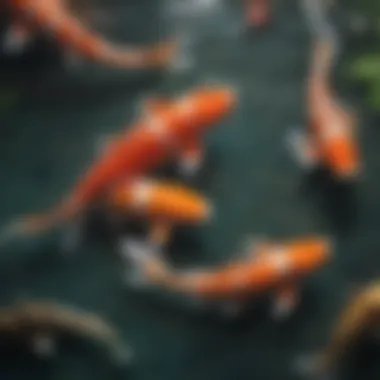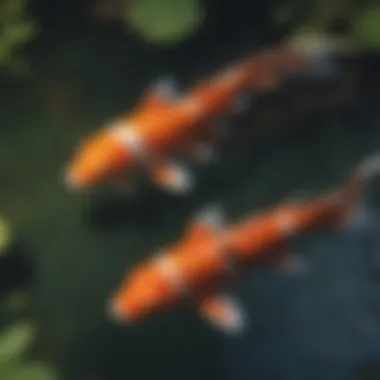Understanding Koi Fish Pricing Factors and Insights


Intro
Koi fish, renowned for their beauty and grace, have become more than just ornamental additions to ponds. They embody tradition, culture, and hobbyist passion. Understanding the pricing of koi fish requires insight into multiple facets that contribute to their market value. This article explores these complexities, helping potential buyers navigate the intricate landscape of koi pricing.
Koi pricing does not merely depend on a fish’s aesthetic appeal. Factors such as breed, health conditions, age, and local economic influences play a significant role in determining price. Buyers must evaluate these parameters carefully to make informed decisions.
Additionally, the sourcing of koi fish presents its own challenges. Knowing where to buy, assessing the quality, and negotiating prices are essential skills for anyone serious about acquiring koi. The goal of this article is to provide a comprehensive view of koi fish pricing, empowering readers to engage confidently in the market.
Factors Influencing Koi Fish Prices
Understanding the factors that influence koi fish prices is crucial for any prospective buyer. Pricing can fluctuate based on various elements, and recognizing these can aid in making informed decisions. This section elaborates on key considerations that affect koi pricing, including breed characteristics, size and age, color patterns, health indicators, breeder reputation, and market trends. Each of these factors plays a significant role in determining the overall value of koi fish.
Breed Characteristics
The breed of a koi fish significantly affects its marketability and price. Some breeds have distinct traits that make them more desirable to collectors and enthusiasts. For example, the Kohaku, known for its white body and red patterns, tends to be a favorite among collectors. On the other hand, varieties like the Shiro Utsuri, characterized by its black and white pattern, may attract a different segment of buyers. Each breed's specific traits and any unique traits within that breed contribute to its overall value.
Additionally, rarer breeds can command higher prices due to demand and limited availability. Collectors often look for unique markings or shapes, which can also raise the price. Thus, understanding these breed characteristics is essential for both buyers and sellers in the koi market.
Size and Age
Size and age are two critical components influencing koi prices. Generally, larger koi fish are more expensive than smaller ones. A fully grown koi fish can take years to reach maturity, leading buyers to pay a premium for these older specimens. Many enthusiasts seek koi that are at least two years old, as they are more vibrant in color and have more defined patterns.
Moreover, the size of the koi can also relate to its health and growth potential. Bigger koi often suggest successful rearing and a healthy vibrant life. However, it is essential to balance size considerations against other factors such as health status and breed characteristics when assessing value.
Color Patterns
Color patterns are pivotal in determining koi prices. High-quality koi fish exhibit vibrant colors and distinct patterns that please the eye. Factors such as clarity, balance, and even distribution of colors come into play. For example, a koi with a well-balanced red and white pattern may fetch a higher price than one with imbalanced coloring.
Subtle variations in shade and intensity can also influence the value of koi. Fish that boast unique color patterns or historical significance often attract higher bids. Therefore, potential buyers should examine color patterns closely, as they significantly influence the overall market value of koi fish.
Health Indicators
Health indicators are vital when evaluating koi fish prices. An unhealthy koi fish might not only be less attractive, but it may also pose risks to the buyer's existing fish. Key indicators of health include clear eyes, smooth skin, and an active swimming behavior. Buyers should always seek koi that demonstrate good health, which can prevent potential long-term costs associated with treating sick fish.
Additionally, koi breeders who maintain high health standards in their stock often market their fish at higher prices. Thus, assessing health indicators is essential not just for immediate purchase decisions but also for understanding long-term value.
Breeder Reputation
The reputation of the breeder can substantially influence koi pricing. Established breeders who possess a track record of producing high-quality koi will often command a premium price. This is because many buyers feel more confident purchasing from breeders known for their expertise and the health of their fish.
On the contrary, lesser-known breeders may offer koi at lower prices, but the risk associated with health and breed quality can make these less desirable. Evaluating a breeder's reputation through reviews, previous customer experiences, and breeding practices can shed light on the potential quality and value of the koi.
Market Trends
Finally, market trends play a crucial role in koi pricing. The prices of koi can be influenced by fluctuations in demand, seasonal trends, and changes in the overall economy. For example, during koi exhibitions and auction events, there can be a spike in interest and prices, whereas off-seasons might see reduced demand.
Understanding the current market trends offers buyers insights into the potential future prices of koi. Researching recent auctions and attending local shows can provide clarity on what varieties are currently popular and may justify price differences between various koi. Keeping abreast of market trends can significantly benefit those looking to invest in koi fish.
Average Price Ranges


Understanding the average price ranges for koi fish is crucial for any potential buyer. This section not only provides guidance on what to expect but also explains how various factors can shift pricing. A comprehensive grasp of typical costs can aid buyers in making informed decisions, avoiding overpriced fish, and ensuring they achieve value for their investment. The koi industry is vast, and within it, prices can vary widely based on different breeding practices, market demand, and geographical factors. Knowing where your desired type of koi sits within the price spectrum is fundamental when you start your search.
Common Types and Their Prices
Common breeds of koi fish often have more standard pricing. Varieties such as Kohaku, Sanke, and Showa are found widely in pet stores and online retailers. For instance, a young Kohaku can range from $20 to $200, depending on its quality and pattern clarity. Sanke, also fairly common, might sit within a similar range.
• Kohaku: $20 to $200
• Sanke: $20 to $150
• Showa: $30 to $250
Younger koi tend to be cheaper. As fish grow and display more attractive qualities, the price will increase. It is important to carefully assess these details when making a purchase.
High-Value Varieties
High-value koi fish varieties can command significantly higher prices due to their rare attributes or lineage. Varieties like the Matsuba or Goshiki can start at $200, with some individuals fetching over $1,000. Buyers should consider factors like color intensity, body shape, and overall appearance to assess value in these specimens.
Some notable high-value varieties include:
• Matsuba: Starting around $200
• Goshiki: Can exceed $1,000
• Asagi: Prices may range from $250 to $2,500 based on quality
Investing in high-value koi can be gratifying. However, it is essential to conduct thorough research to understand whether the investment matches your expectations and expertise.
Affordability and Budgeting
Budgeting for koi fish is vital for ensuring a successful investment. While some may perceive koi ownership as a luxury, there are options for every wallet. Assess how much you are willing to spend on acquiring the fish, ongoing maintenance, and related costs like filtration and feeding. Affordable entry-level koi can start from $10 or $15, while enthusiasts who seek quality could invest in the low hundreds.
In terms of budgeting, consider:
- Initial Purchase: Price of the koi itself
- Tank or Pond Setup: Filtration, plants, and decor
- Ongoing Care: Food, medications, and seasonal care
A balanced budget will support both the initial purchase and the ongoing health of your koi. This understanding of affordability can make koi keeping an accessible hobby for many, provided they plan accordingly.
Where to Buy Koi Fish
Finding the right place to purchase koi fish is crucial for any prospective owner. This decision affects not just the initial price, but also the health and vigor of the fish, which can have long-term implications on their lifespan and happiness. Choosing the right source ensures that you acquire quality specimens that thrive in your environment. Several avenues exist for acquiring koi fish, each with its own advantages and considerations.
Local Pet Stores
Local pet stores offer a convenient option for purchasing koi fish. These establishments usually stock a range of koi, from common to more exotic breeds. One benefit of buying from local pet stores is the instant gratification of taking your new fish home immediately. Additionally, employees can often provide valuable insights about the care and maintenance of koi.
However, there are limitations. Not all pet stores have a comprehensive selection, particularly for more rare varieties. Furthermore, the condition of the fish can vary significantly; it is essential to assess their health and environment before making a purchase. Look for clear water, active fish, and a knowledgeable staff who can answer your questions.
Online Retailers
Online retailers have become increasingly popular for buying koi fish. Sites like Koi Zone or Nishikigoi.com provide a vast selection of breeds and sizes, along with detailed information about each fish. The main advantage of online shopping is the ability to compare prices and varieties easily. Furthermore, many online retailers offer guarantees regarding the health of the fish during transit.
Yet, buying koi online does involve certain risks. Without seeing the fish in person, it may be difficult to assess quality accurately. Shipping can also impact the health of the fish if not handled correctly. Comparing seller reviews and asking questions about shipping practices can help alleviate concerns. Furthermore, ensure to check the return policy in case the delivered fish does not meet expectations.
Koi Shows and Auctions
Koi shows and auctions present unique opportunities for koi enthusiasts to find high-quality fish. At these events, breeders showcase their best specimens, and buyers can often bid on prized items. This setting allows potential buyers to observe the fish's movement and health firsthand. Additionally, buying directly from breeders can facilitate better communication regarding the fish’s genetics and care requirements.
On the downside, attending these events might require traveling and could involve higher prices for prized fish. Participating in auctions also demands some knowledge of bidding to avoid overpaying. Evaluate your budget and do some research on the breeders and their reputations before making a commitment.
"Informed buying not only enhances your experience but also ensures the longevity and health of your koi."


Each purchasing avenue comes with its own set of pros and cons. By understanding these options, you can make informed decisions that align with your koi-keeping goals.
Assessing Koi Fish Quality
Assessing the quality of koi fish is vital for making informed purchasing decisions. Potential buyers need to understand that the quality directly influences not only the market price but also the long-term enjoyment and satisfaction derived from owning these fish. High-quality koi not only possess desirable traits but also exhibit physical health, which can significantly reduce future care costs. Therefore, it is essential for buyers to familiarize themselves with effective assessment techniques to ensure they are making a worthy investment.
Visual Inspection Techniques
The first step in assessing koi fish quality involves visual inspection. Potential buyers should closely observe the physical characteristics of the fish. Look for bright, vibrant colors, as dull or faded colors may suggest poor health. Examine the body shape; healthy koi should have a symmetrical form without any visible deformities. Keep an eye on the fins, which should be fully extended and free of tears or discoloration. Observing the koi while it swims can also reveal its general vitality; a healthy koi will swim actively rather than float or lag behind.
Here are some main aspects to consider during a visual inspection:
- Color Intensity: Rich and clear colors are desirable.
- Body Shape: Ideal koi should be well-balanced and muscular.
- Fins and Tail Condition: Look for uniform shape and strength.
- Skin Quality: The skin should appear smooth and shiny without blemishes.
Understanding Fish Health Metrics
Understanding health metrics is crucial for assessing koi quality. Buyers should inquire about the fish's overall health history. A reliable seller will provide information on the fish's medical treatment, including vaccinations or disease history. Important metrics like water quality parameters during the fish's previous environment can also be indicative of health. For instance, koi kept in optimal water conditions tend to be healthier.
Some key health indicators to consider are:
- Respiratory Rate: Normal breathing should be steady and rhythmic.
- Appetite: Healthy koi show a strong desire to feed.
- Skin and Gill Condition: Check for lesions or irritations on the skin and gills.
Consulting Experts
Engaging with experts can offer deeper insights into koi quality. Consulting with a veterinarian who specializes in fish or a koi enthusiast with extensive knowledge can be helpful. They can provide valuable information about what to look for in high-quality koi and may assist you in understanding the genetic background of different breeds. This information can lead to better decision-making, ensuring you select the healthiest and most vibrant fish available.
Additionally, experts may recommend specific facilities or breeders known for their quality, thus connecting you with trusted sources for your koi fish.
Investing time to assess koi fish quality can save money in the long run. Choosing high-quality fish can lead to fewer health issues and higher enjoyment.
To summarize, assessing koi fish quality involves visual inspections, understanding health metrics, and consulting experts. Each of these components plays a crucial role in making an informed decision. Being knowledgeable about these areas not only enriches the buying experience but also enhances the overall enjoyment of koi ownership.
Negotiating Koi Fish Prices
Negotiating koi fish prices presents a significant aspect for both buyers and sellers. Understanding this process is crucial in reaching a mutually agreeable price that reflects fair market value. Koi can vary greatly in price based on factors such as breed, size, and overall quality. Therefore, a well-informed negotiation can lead to better decisions and possibly enhance the long-term value of the investment.
Effective Negotiation Strategies
To maximize the chances of securing a favorable deal, it is valuable to employ effective negotiation strategies. Start by researching current market trends and understanding the typical price ranges for the specific type of koi you are interested in. This knowledge empowers you during discussions with sellers. Here are some strategies to consider:
- Prepare Your Information: Gather data on the koi you are looking at—its breed, age, and health metrics. Having this information ready can enhance your position.
- Set a Budget: Know the maximum amount you are willing to spend. This helps in staying focused during negotiations.
- Be Patient: Rushing decisions may result in higher costs. Take your time to carefully evaluate and discuss the options available.
These strategies form the foundation for more complex negotiations.
Assessing Market Value for Negotiation
An essential part of negotiating koi prices is assessing the market value accurately. Understanding what similar koi are selling for in your area, or online, provides valuable insights. Market conditions can influence these prices significantly. Thus, factors such as seasonal demand and local interest can change the landscape. When considering market value, observe the following:
- Research Local Listings: Check platforms like Facebook Marketplace or koi-specific forums like Reddit to see what others are charging.
- Visit Local Shows: Attending koi shows or auctions can give you a firsthand look at pricing trends and the quality of fish available.
- Consult Experts: Speaking with reputable breeders can further clarify what constitutes fair pricing.
Using these practices will enable you to calculate a fair starting point for negotiations.


Building Rapport with Sellers
Lastly, building rapport with sellers can significantly impact negotiation outcomes. People are often more willing to negotiate favorably if they feel a personal connection. Establishing trust and understanding can lead to better deals. Here are some tips for building rapport:
- Be Respectful and Courteous: Simple manners go a long way in fostering a positive interaction.
- Ask About Their Experience: Showing genuine interest in the seller's background can help establish a relationship.
- Be Honest About Your Intentions: Clearly communicate your interest in the koi and your budget. Transparency can foster goodwill.
In summary, effective negotiation strategies, an understanding of market value, and relationship-building can empower buyers in the koi fish market. Engaging in negotiations with confidence can help you secure not just a fair price but also a healthy and valuable koi fish product.
Long-Term Value of Koi Fish Investments
Investing in koi fish can be both rewarding and challenging. Understanding the long-term value is critical for anyone considering it as a hobby or investment. The value of koi fish can fluctuate over time based on several factors. Proper investments not only enhance your collection but also may lead to significant monetary gains in the future.
Potential for Appreciation
Koi fish can increase in value as they grow older and larger. Certain breeds, such as the Kumonryu or the Showa, often appreciate in value significantly. The key elements for appreciation include:
- Rarity: Rare breeds or those with unique color patterns are often highly sought after.
- Market Demand: Trends in popularity can dictate price. Observing market tendencies is crucial.
- Certification: Fish that come with registration from noted breeders tend to have a higher resale value.
Potential buyers should stay informed about what breeds are trending in terms of appreciation. While some fish may plummet in value due to market saturation, others might soar unexpectedly.
"Investing in koi is not only a financial decision but also an emotional journey that requires attention to detail and a keen understanding of trends."
Care Costs to Consider
Owning koi fish does not end with the purchase. The costs associated with their care can accumulate significantly over time. Important aspects to consider include:
- Pond Setup: Initial setup can be costly, with filtration systems and water quality testing kits, which are non-negotiable for healthy fish.
- Maintenance: Regular pond maintenance, like cleaning filters and monitoring water quality, incurs costs.
- Feeding: Quality food is essential for growth and health. Budgeting for various food types throughout the seasons is necessary.
- Health Checks: Routine health checks and treatments for parasitic infections or bacterial issues add to the ongoing costs.
All these factors contribute to the long-term financial commitment of koi care. Adjusting your budget to accommodate these expenses is advisable.
Environmental Considerations
The environment in which koi are kept plays an essential role in their health and longevity. Notable environmental factors include:
- Pond Size: A larger pond supports healthy growth and reduces stress levels in fish. Maintaining a proper habitat is critical.
- Water Quality: Poor water quality leads to health issues. Regular testing and treatment are necessary.
- Climate: Koi should be acclimatized based on the seasonal climate of their habitat. Different temperatures affect their metabolism and overall health.
- Protection from Predators: It is vital to secure the pond area to protect koi from birds and other animals.
Investment in a proper environment enhances the quality of life for the koi. Good care leads to happier fish, which, in turn, contributes to better appreciation in their value.
End
The conclusion is a crucial part of this article. It synthesizes the information presented throughout the text, allowing readers to grasp the essence of koi fish pricing. Understanding the components that affect prices leads to more informed decisions when investing in koi.
In this section, we highlight the key aspects shared earlier. These include various factors such as breed characteristics, color patterns, and breeder reputation. Each of these influences the overall market value of koi fish.
Moreover, the potential for appreciation in value over time can make koi fish a worthwhile investment. However, care costs and environmental considerations must be taken into account, as they may impact the long-term enjoyment of owning koi fish. By recognizing these factors, buyers can make smarter choices that align with their goals.
In essence, being well-informed about koi fish pricing allows for greater confidence in purchases. This not only benefits buyers but also contributes to a better understanding of the hobby as a whole. Knowledge empowers individuals to navigate the market more effectively, fostering a passion for koi that can last for years to come.
Summary of Key Points
- Breed Characteristics: Different breeds have varying values based on their unique traits.
- Size and Age: Generally, larger and older koi command higher prices.
- Color Patterns: Rare patterns can significantly increase a koi's market value.
- Health Indicators: Healthy fish are more desirable, affecting their price.
- Breeder Reputation: Established breeders usually have higher-priced koi due to trust and quality.
- Market Trends: Keeping an eye on trends helps in understanding price fluctuations.
Final Recommendations
- Research before purchasing: Understand the different factors affecting koi prices.
- Assess the long-term value: Consider not just the initial cost but also ongoing care and potential appreciation.
- Consult experts when needed: Do not hesitate to seek advice from knowledgeable sources, especially if you are new to koi keeping.
- Buy from reputable sources: Prioritize trusted breeders or sellers to ensure quality and health of the fish.
- Stay updated on market trends: Being aware of changes in the hobby will assist in making informed purchasing decisions.
By following these recommendations, prospective koi owners can ensure they invest wisely in their aquatic companions.















